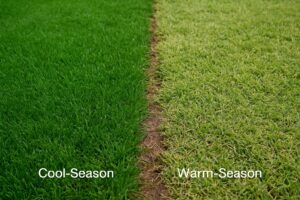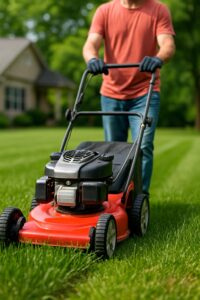The Ultimate Lawn Care Guide: Secrets to a Lush, Green Yard All Year Round

Why Lawn Care Is Worth Your Time
Lawn care isn’t just about looks. A well-kept yard creates a sense of pride, increases your home’s value, and improves your quality of life. Lawns also benefit the environment by reducing erosion, filtering water, trapping dust and pollutants, and moderating temperatures around your home.
A healthy lawn also encourages time spent outside. Whether it’s a quiet morning coffee on the porch or a weekend game of catch, your yard becomes an inviting extension of your home. With the right knowledge and some consistency, anyone can enjoy a thriving, beautiful lawn.
Step 1: Understand Your Grass Type
Before you begin watering, mowing, or fertilizing, you need to know what kind of grass you’re working with. Different grasses have different needs. Understanding whether you have a cool-season or warm-season variety will guide your entire lawn care strategy.
Cool-season grasses, such as Kentucky bluegrass, fescue, and perennial ryegrass, grow best in spring and fall. They thrive in cooler climates and tend to struggle during intense summer heat.

Warm-season grasses, like Bermuda, St. Augustine, and Zoysia, are better suited for hot weather and typically grow during late spring through summer. They often go dormant and turn brown in cooler months.
Knowing your grass type helps you make better decisions about when to fertilize, how much to water, and how often to mow. If you’re unsure, take a sample to a local garden center or consult a regional lawn care guide.
Step 2: Mowing the Right Way
Mowing seems simple, but doing it wrong can lead to major lawn problems. The biggest mistake most people make is cutting the grass too short. When grass is cut too low, it weakens the root system and exposes the soil to sun, which dries it out and gives weeds room to grow.
Stick to the one-third rule—never cut more than one-third of the grass blade in one mowing session. This helps keep grass healthy and better able to compete with weeds.
Taller grass also promotes deeper root growth, which improves drought tolerance. For most grass types, keeping your lawn around 2.5 to 4 inches tall is ideal.
Use sharp mower blades. Dull blades tear the grass rather than slicing it cleanly, which can lead to jagged edges, discoloration, and increased vulnerability to disease.
Alternate your mowing pattern each week to prevent soil compaction and ruts from forming in the same direction.
Step 3: Smart Watering Habits
Watering can be one of the trickiest aspects of lawn care because too much or too little can both cause problems. Most lawns need about one to one-and-a-half inches of water per week, including rainfall.
Rather than watering a little every day, water deeply once or twice a week. Deep watering encourages roots to grow downward, making your grass more resilient in hot or dry conditions.
The best time to water is in the early morning. Watering before 10 a.m. reduces evaporation and gives your lawn time to dry before nightfall, lowering the risk of fungal diseases.
Avoid watering in the evening, as sitting moisture overnight can lead to mold, mildew, and lawn diseases. Use a sprinkler system or soaker hoses to distribute water evenly.
A simple rain gauge or even a shallow container like a tuna can placed on the lawn during watering can help you monitor how much water your lawn is getting.
Step 4: Fertilize with Purpose
Fertilizing helps feed your lawn the nutrients it needs to stay healthy, green, and thick. But like watering, it needs to be done correctly.
Cool-season grasses should be fertilized in early spring and again in the fall, while warm-season grasses benefit most from fertilization during their peak growing season—late spring through summer.
Use a slow-release fertilizer to avoid nutrient overload, which can cause rapid growth and increase mowing needs. Look for a balanced fertilizer with nitrogen, phosphorus, and potassium, and always follow the product instructions.
It’s also a good idea to test your soil every two to three years. A soil test will tell you what nutrients your lawn is lacking and help you choose the right fertilizer to meet those specific needs.
Applying fertilizer when the lawn is dry and then lightly watering afterward helps it absorb more effectively and reduces runoff.
Step 5: Prevent and Control Weeds
Weeds are one of the biggest frustrations in lawn care. They compete with your grass for nutrients, water, and sunlight. The best defense against weeds is a thick, healthy lawn, but additional weed control is often necessary.
Start with a pre-emergent herbicide in early spring to prevent weeds like crabgrass from taking root. These products create a barrier in the soil that stops weed seeds from sprouting.
If weeds are already present, use a post-emergent herbicide targeted to the type of weed you’re dealing with. Be careful when applying herbicides—only
treat affected areas to avoid damaging the rest of your lawn.
For smaller infestations, hand-pulling weeds (including the roots) is an effective option. This works best after a rain when the soil is soft.
Mulching around garden beds and trees helps prevent weeds from spreading into your lawn, and consistent mowing keeps them from seeding.
Step 6: Aerate and Dethatch Annually
Over time, your soil can become compacted, especially in high-traffic areas. Compacted soil prevents air, water, and nutrients from reaching grass roots, which leads to poor growth.
Aeration relieves this compaction by creating small holes in the lawn, allowing nutrients to reach deeper into the soil. This process is typically done in the fall for cool-season grasses or late spring for warm-season grasses.
Thatch is a layer of dead grass, roots, and organic matter that builds up on the surface of the soil. When it gets too thick—more than half an inch—it can block water and nutrients.
Dethatching removes this layer and helps the grass breathe. This can be done manually with a thatching rake or with a dethatching machine for larger lawns.
Aerating and dethatching your lawn once a year improves drainage, promotes deeper root growth, and increases your lawn’s resilience to weather stress.
Step 7: Repairing Bare Spots
Bald patches can appear for many reasons: foot traffic, pests, pet urine, or poor soil. Fortunately, they’re easy to fix with a bit of attention.
Rake the area to remove any dead grass or debris and loosen the soil. Apply a thin layer of topsoil or compost, then spread grass seed that matches the rest of your lawn.
Lightly press the seed into the soil with a rake or by walking over it. Keep the area moist, watering lightly once or twice a day until the new grass is well-established.
For best results, patch in the fall for cool-season grasses or in late spring for warm-season grasses.
Step 8: Customize Your Care by Season
Each season brings different challenges and opportunities for lawn care. Here’s a simple breakdown of what to focus on throughout the year:
Spring
-
Rake away debris and dead grass.
-
Apply pre-emergent weed control.
-
Fertilize cool-season grasses.
-
Begin watering and mowing as growth starts.
Summer
-
Mow high to shade roots.
-
Water deeply and early in the morning.
-
Monitor for pests and disease.
-
Fertilize warm-season grasses.
Fall
-
Aerate and overseed cool-season lawns.
-
Apply a slow-release fertilizer.
-
Continue mowing until growth stops.
-
Remove fallen leaves regularly.
Winter
-
Limit foot traffic on frozen or dormant lawns.
-
Clean and store your tools.
-
Plan for spring improvements.
-
Inspect for snow mold or other winter damage.
Avoid These Common Lawn Mistakes
Even with the best intentions, some habits can do more harm than good. Here are a few pitfalls to avoid:
-
Mowing too short weakens your grass and encourages weeds.
-
Overwatering leads to shallow roots and fungal diseases.
-
Skipping aeration keeps nutrients from reaching the roots.
-
Overfertilizing can burn your grass and pollute local waterways.
-
Ignoring your grass type results in improper timing for treatments.
Instead of trying to do everything at once, focus on building smart habits one season at a time.
Going Organic: A Healthier, Greener Approach
If you want to reduce your environmental impact or avoid synthetic chemicals, organic lawn care is a great alternative. It requires more patience but offers long-term benefits to your lawn and local ecosystem.
Use compost or natural fertilizers like bone meal and alfalfa meal. Control weeds with vinegar solutions, corn gluten meal, or manual pulling. Introduce beneficial insects and use neem oil or insecticidal soaps for natural pest management.
Organic care improves soil structure, encourages biodiversity, and reduces chemical runoff, making your lawn a safer place for pets, kids, and pollinators.
Final Thoughts: Consistency Beats Perfection
Lawn care is not about achieving perfection overnight—it’s about small, steady steps that build lasting results. Whether your yard is large or small, urban or rural, the principles of healthy lawn care stay the same: mow correctly, water wisely, feed intentionally, and respond to your lawn’s needs as they change throughout the year.
Stick to a seasonal schedule, stay observant, and don’t be afraid to adjust your routine based on what you see. Every lawn is unique, and learning what works for yours is part of the journey.
Before long, you’ll find your lawn not only looks better—but feels better to spend time on. And that’s the true reward of great lawn care.

